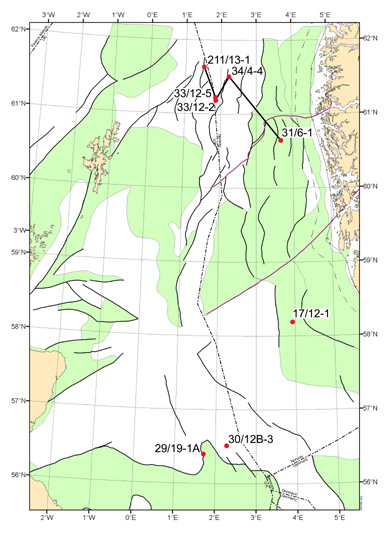Hegre Group
(See also NPD Bulletin no. 3 for older
definition)
Name
Named after the bird Heron (Norwegian: hegre).
Type area
The type area is the northern part of the northern North Sea. The
following Norwegian wells are used to illustrate the Group:
31/6-1,
34/4-4
and 33/12-5.

Locations of wells (click image for full size).
Thickness
The Hegre Group is thickest in the eastern part of the basin where major
subsidence occurred along the present Norwegian coastline. More than 2 km
of Triassic sediments has been penetrated in east (well NO 31/6-1). The
Group is thinning towards the west in the northernmost part of the
northern North Sea while in the southern part (Central Trough and Moray
Firth) substantial thicknesses are recognized. There might have been
depositional systems along the East Shetland Platform during deposition of
the Hegre Group as great thicknesses of unspecified Triassic strata have
been drilled here (see Comments below).
Lithology
The Hegre Group consists of intervals of interbedded sandstone,
claystones, mudstones and shales associated with sequences of dominantly
sandstone or shale/claystone. Shales and claystones/mudstones usually
have reddish colours whereas the sandstones show a range in colour from
white, light grey, orange to brick red. The grain size varies from very
fine to very coarse and the sediments are in parts of pebbly nature. The
Hegre Group also has intervals of white limestone, anhydrite and
brownish-red marl.
Boundaries
The base of the Hegre Group represents in the southern and central part of
the northern North Sea a transition from Zechstein carbonates and
evaporites to Triassic silica-clastics. It represents a transition from
high gamma and sonic readings of the carbonate dominated Zechstein facies
to low gamma and sonic of the Smith Bank Formation. It is uncertain which
wells show a continuous succession of Permian to Triassic silica-clastics,
as the lower boundary is generally not detectable as it represents a
continuous succession of Rotliegendes red beds to Triassic sediments of
similar characteristics. The Rotliegendes as well as the Triassic
succession are generally barren of age diagnostic taxa. In the
northernmost part of the Basin where Zechstein facies is absent, the base
of the Hegre Group represents a disconformity to Caledonian basement (well
NO 31/6-1).
Distribution

Wells of Triassic strata which are the Hegre Group (click image for
full size).
Occurrences of group tops in wells
Comments
The area close to the margin of the East Shetland Platform and margin of
the present Norwegian mainland shows generally a succession of sandstones
and mudstones. A succession (of a well) which does not show a complete
Triassic succession making it possible to subdivide it based on the
overall lithostratigraphic pattern and totally absence of age diagnostic
material makes it very difficult or impossible to decide which Triassic
unit the sediments belong to. The actual succession should therefore be
assigned unspecified to the Hegre Group.
While the Cormorant Formation by Vollset & Doré (1984) was applied only to
certain areas where a subdivision of Triassic is impossible, it is
suggested here that unspecified Triassic strata should generally be
assigned to undifferentiated Hegre Group rather than to a formation of
unspecified strata. The Cormorant Formation is therefore here suggested to
be abandoned.



